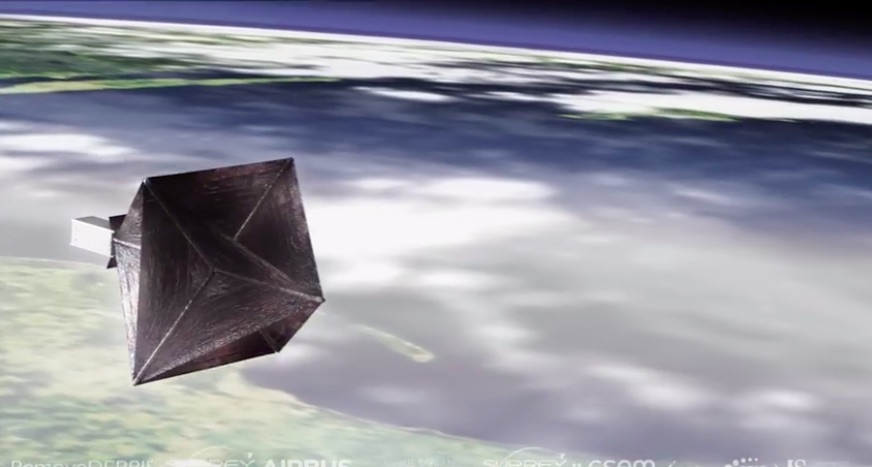At Small Satellite Conference, Frustration About Lagging Efforts to Deal With Space Junk
LONDON — A British debris-removal satellite was deployed this summer from the International Space Station to help researchers figure out new techniques to clean up space junk that increasingly is becoming a hazard to the ISS and to other satellites.
The experimental RemoveDebris mission in September successfully cast a net to catch a dead satellite in space. Next year it will try to capture the target with a harpoon.
A harpoon that grabs orbital debris sounds like a cool idea, but putting up more hardware in space to clean up debris is probably not a sustainable proposition, said Fred Kennedy, the director of the Defense Advanced Research Projects Agency's Tactical Technology Office. [7 Ways to Clean Up Space Junk]
"If I have to bring out a harpoon for every piece of debris, I'm not sure I've helped. I may be contributing to the problem," Kennedy said Nov. 5 at the Small Satellites and Disruptive Technology Focus Day conference hosted by the SMi Group.

DARPA has studied the problem for years and concluded that some active removal of debris is needed but the long-term answer is self policing, Kennedy said. "If the industry is putting up a thousand satellites, they have to figure this out," he said. "All the mega constellations are aware, they are working that problem." The national security community and the civilian space agencies are trying to figure out how to better track debris as part of a larger space traffic management effort. But as broadband satellite companies start building their constellations, Kennedy said, they should have a plan to de-orbit their out-of-service spacecraft.
"It would be much better if companies like SpaceX, OneWeb and Telesat would take care of the problem themselves and have a plan," he said. "I know they have thought about it." Their motivation is not just to make space safer for satellites but also to preempt an onslaught of regulations that might come in the future if debris continues to proliferate.
The junk-grabbing satellite tested from the International Space Station has been five years in the making. "The challenge is quite substantial," said Luis Gomes, chief technical officer of Surrey Satellites Technology Ltd., the company that designed the RemoveDebris spacecraft. So much can go wrong when trying to grab objects in space, he said. "We continue to study and analyze."
Get the Space.com Newsletter
Breaking space news, the latest updates on rocket launches, skywatching events and more!
"At first we thought it was a crazy idea," said Gomes.
The $20 million project is led by the Surrey Space Centre at the University of Surrey and co-funded by the European Commission. The RemoveDebris mission includes four experiments. In September it deployed a net developed by Airbus to capture a target cubesat. The next test is a vision-based navigation system from Airbus that uses 2D and 3D light detection and ranging technology to track a cubesat. The harpoon was developed by Airbus and next year will be fired at 20 meters per second to penetrate a target made of composite material. In the final experiment, RemoveDebris will deploy a large drag-sail to speed de-orbit into the Earth's atmosphere.
Kennedy said these technology efforts are impressive but impractical. "Clearing all the debris out of LEO is expensive," said Kennedy. "That's what I fear. That this takes us to a place where I don't know if it's affordable."
DARPA published a study in 2011 called "The Catcher's Mitt Study" that looked at the debris problem and its future growth. The report said that active debris removal would be needed at some point to maintain an "acceptable level" of operational risk. It noted that "failure to address this problem has significant implications for the success of future space missions due to the potential increased number of on-orbit collisions with non-trackable, yet lethal, debris fragments."
This story was provided by SpaceNews, dedicated to covering all aspects of the space industry.
Join our Space Forums to keep talking space on the latest missions, night sky and more! And if you have a news tip, correction or comment, let us know at: community@space.com.

Sandra Erwin covers the military and national security beat as a Senior Staff Writer at SpaceNews. Sandra, based in Arlington, Virginia, specializes in Defense Department and Intelligence Community space programs, policy, budgets, technology and the industry that supports this sector. She joined SpaceNews in October 2017. Before coming to SpaceNews, Erwin covered the U.S. military, the Pentagon, Congress and the defense industry for over two decades as editor of the National Defense Industrial Association's National Defense Magazine and Pentagon correspondent for Real Clear Defense.










